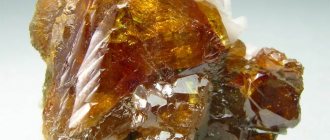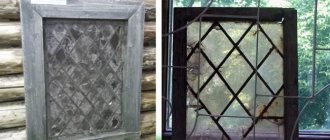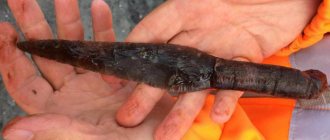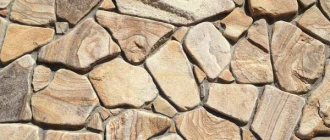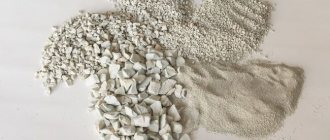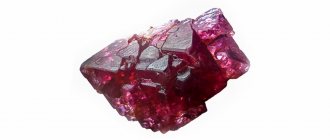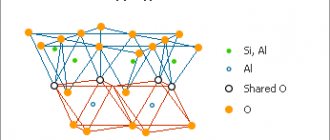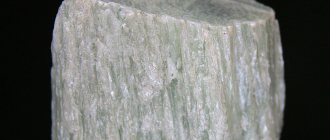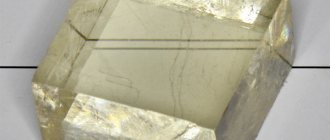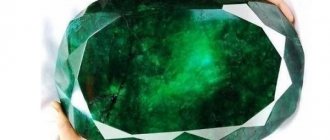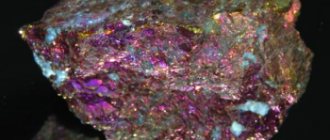History and origin
The first finds and use of feldspar go back to ancient times. No one knows the exact time when the mineral was discovered. There are only scattered references to the stone in handwritten sources from different times.
The name “feldspar” is German, although it has Swedish roots. This is because the agricultural land located on the lands of modern Sweden is completely strewn with feldspar. Mineralogists believe the origin of the name is Swedish-German, where “feldt” means “arable land” and “spath” means bar. In 1740, the German term "feldspat" was introduced. In addition, scientists claim that the Russian-language term “cleavage” should have been pronounced as “spatnost”.
In mineralogy, feldspar is understood as a whole group of minerals. The origin of the stone is magmatic. In fact, feldspar is the rock-forming material of our planet. In its pure form, this nugget is inconspicuous. However, pure spar is rare. The bulk of stones include various impurities, which separates them by chemical composition, type, and name.
This is interesting! The Moon is rich in feldspar, like the Earth. This mineral is not uncommon in outer space - most meteorites contain feldspar.
The fact that spar has been used by people at all times is confirmed by archaeological finds during excavations. Nugget jewelry made by people of ancient civilizations has been found in Egypt and other Eastern countries. Scientists of all eras have studied the capabilities of this mineral. Research in this area is still being carried out.
Form of being in nature
All feldspars are characterized by growth twins (intergrowth, intergrowth), as well as transformation twins that arise as a result of phase transformations in feldspathic block crystals.
In normal twins (face law), the twin axis is perpendicular to the fusion plane, which is both the twin plane and the plane of symmetry of the twin (usually the most common face). In parallel twins (law of axis), the twin axis lies in the plane of fusion of the twin, which can be any face lying in the zone of which the given twin axis serves as an edge. In complex twins (complex laws), the twin axis is perpendicular to one of the edges and lies in some important crystallographic plane, which is the plane of fusion of twins. Sometimes a distinction is made between Carlsbad-A (accretion plane - (010)) and Carlsbad-B (accretion plane - (100)) twins [121]. The Akline-A law is considered as a special case of the pericline law with the fusion plane (001), and the Ala-A and Ala-B laws are considered as a special case of the Esterel law with the fusion planes (001) and (010). The most common are twins with a fusion plane (010). For monoclinic Potassium feldspars, the most characteristic are Carlsbad, Manebach and Baven twins, for triclinic (K feldspars, Na-feldspars, plagioclases) - albite, as well as pericline and Carlsbad. Due to their symmetry, albite and pericline twins are impossible in monoclinic feldspars (a good diagnostic feature). On the contrary, they are common in triclinic feldspars. The position of the “rhombic section” depends on the chemical composition of the feldspar. For this reason, the orientation of albite-pericline twins in the microcline and in the essentially sodium alkali feldspar - anorthoclase is different: under a microscope in the microcline in sections along (010) only pericline twins are observed (at an angle of 83° to the cleavage cracks along (001)), in in the section along (100) - only albite twins (parallel to the cleavage cracks along (010)), and in the section along (001) - a lattice of albite and pericline twins at an angle of 90° (microcline lattice)', in anorthoclase in sections along (010) ) only pericline twins are also observed, but they are almost parallel (at an angle of only 2-5°) to the cleavage cracks along (001), in the section along (100) there is a lattice of albite and pericline twins at an angle of 90°, and in the section along ( 001) - only albite twins parallel to cleavage cracks along (010). Complex twins are widespread in feldspars, for the study of which Vardanyants developed a special theory of “twin triads.” A structural explanation for twinning was given by Taylor et al. using orthoclase as an example. The twins are connected through oxygen atoms common to both twinned individuals, and due to the fact that they are located on common symmetry elements, the growth of a single single crystal continues (in the orientation of each of the twinned individuals). In this case, there is no rupture or significant distortion of the quadruple rings of [(Si,Al)O4] tetrahedra in the framework of the structure. In Manebach twins, the (010) symmetry planes in both individuals coincide, and the common oxygen atoms O(Al) lie on common rotation axes. In Bavin twins, the common oxygen atoms O(A2) are on the (010) symmetry planes or deviate from them by only 0.2 A, and the symmetry planes themselves in the twin individuals are oriented at an angle of 90°. In Carlsbad twins, two common oxygen atoms O(Al) and O(A2) lie respectively on the rotation axis [010] and symmetry plane (010) of one of the individuals, and the other pair of common atoms O(Al) and O(A2) lie on axis [010] and plane (010) of the second individual. Since the O(Al) atom at a height of 4.7 A in the twin and in the single crystal is in the same position (the Si-O-Si-O chains in the twin differ from the configuration in the single crystal only by a slight rotation of the oxygen atoms around the silicon atoms in [ Si(1)O4]- and [Si(2)O4]-tetrahedra at heights of 4.1 and 5.05 A), intergrowth twins (“contact twins”) are formed along the (010) plane. However, since it is also a plane of symmetry, “right” and “left” twins are possible. And since the same position is occupied by O(Al) atoms at a height of 1.8 A in the Si-O-Si-O chain of the second twinned individual, in this case “germination” twins are also possible.
Albite and pericline twins in triclinic feldspars, according to Taylor et al., are obtained, respectively, by reflection in the (010) plane or rotation around the [010] axis, which is close to perpendicular to (010). Therefore (especially with polysynthetic twinning or with simultaneous albite-pericline twinning), the twin increases its symmetry to monoclinic. For albite-pericline twins in microcline (“M”-twins, “microcline” lattice), this is evidence of its formation from primary monoclinic feldspar as a result of solid-phase transformations. In monoclinic feldspars, albite and pericline twins are impossible, since [010] = perpendicular to (010).
Aggregates.
Mining locations
Feldspars are mined everywhere on almost all continents of the Earth. However, each group of mineral has distinct conditions of origin and occurrence. The main share of mining is carried out in parallel with granite. The nugget is mined in industrial quantities in the following areas:
- Russia.
- Sweden.
- Ukraine.
- Poland.
- Norway.
- Kazakhstan.
- Japan.
- Germany.
- Islands of Madagascar.
Jewelry spar occurs in other places:
- Adularia is mined high in the mountains of India, Tajikistan, and the island of Sri Lanka. The higher above sea level the mineral lies, the better and more expensive the gem.
- Labradorite is found on the lands of Greenland, India, Ukraine, Canada, Finland, and China.
- Amazonite occurs in the territories of Brazil, African countries, India, and Canada.
- The Australian continent, America, Kyrgyzstan, and the mountain ranges of Italy and Mexico are rich in orthoclase.
Feldspar is highly valued in industry. The nugget is used to make glass, ceramics, abrasives, some types of rubber, as well as in electronics and in the creation of cosmetics.
Areas of use
The stone is used not only in the manufacture of jewelry, but also in such areas as:
- used in the manufacture of ceramic and glass products, paint, rubber;
- used to produce aluminum, rubidium;
- taken to create light abrasives used in cosmetology and soap making;
- used for the manufacture of insulators and electrodes;
- mineral bars serve as an excellent facing material.
The precious mineral is used in the manufacture of jewelry and costume jewelry. Green and blue specimens are placed in a silver frame or in alloys containing silver. As a rule, gold contains a yellow or red mineral.
Physical properties
Feldspars of any group are identical in physical properties, but different in chemical composition. The mineral is a plate-shaped stone, heterogeneous in composition, often formed in the form of symmetrical twin crystals.
| Property | Description |
| Formula | { K, Na, Ca, sometimes Ba }{ Al2Si2 or AlSi3 }O8 |
| Hardness | 5 — 6,5 |
| Density | 2.54—2.75 g/cm³ |
| Refractive index | 1,554—1,662 |
| Melting temperature | Albita-1100°С, Anortita-1550°С |
| singonia | Monoclinic or triclinic. |
| Cleavage | Perfect. |
| Kink | Stepwise uneven. |
| Shine | Glass. |
| Transparency | From translucent to opaque. |
| Color | From white to bluish or reddish. |
A nugget is formed in an acidic environment due to magmatic processes occurring in the earth's crust. Feldspars are endowed with an iridescent effect, the luster of the minerals is glassy or mother-of-pearl. Any of the spars is destroyed by hydrofluoric acid. Hydrochloric acid is also destructive for plagioclases.
Also read: Dolomite - a natural unusual stone
Almost all feldspars are representatives of solid solutions of the ternary system of the isomorphic series K[AlSi3O8] - Na[AlSi3O8] - Ca[Al2Si2O8], the last members, respectively, are orthoclase (Or), albite (Ab), anorthite (An). There are two isomorphic series: albite (Ab) - orthoclase (Or) and albite (Ab) - anorthite (An).
Properties and uses of stone
People use feldspar for a variety of purposes:
- for the production of glass and ceramics;
- for the production of rubidium and aluminum;
- in cosmetology;
- for the production of abrasives;
- in the production of mineral paints;
- for decorative purposes for making crafts and jewelry;
- for exterior decoration of buildings (labradorite, amazonite);
- for processing radioactive waste.
Physicochemical characteristics
The chemical formula of feldspar is complex - (K, Na, Ca, sometimes Ba)(Al2Si2 or AlSi3)O8. It indicates that it is an aluminosilicate and contains the following components:
- alumina;
- silica;
- potassium oxide;
- sodium oxide;
- calcium oxide.
Lithium, cesium, lead, barium, boron, rubidium, etc. may be present as impurities. Physical and chemical properties of feldspar:
- hardness 6.0–6.5 points;
- density 2.54–2.75 g/cm3;
- glass shine;
- the fracture is uneven, stepped;
- melting temperature from 1100 °C to 1500 °C;
- iridescence effect;
- layering;
- insoluble in acids, except concentrated hydrochloric and hydrofluoric acids.
The structure of feldspar is a silicate with a three-dimensional framework of aluminum and silicon, which is endlessly duplicated. The crystal lattice is based on a tetrahedron (triangular pyramid).
Here's a video of what the mineral looks like:
Medicinal properties
Feldspar is actively used in lithotherapy. He is capable of:
- restore mental balance, help fight depression (orthoclase, amazonite and adularia);
- reduce pain in arthritis, arthrosis, osteochondrosis (Labrador);
- normalize vascular tone, have a positive effect on heart function (amazonite);
- help with liver diseases (albit);
- have a calming, hypnotic effect (andesine, amazonite);
- improve skin condition, especially with skin diseases (amazonite);
- help with kidney diseases (albit, labradorite).
The magical properties of feldspar
According to magicians, the mineral affects the owner in a positive way:
- enhances concentration on business, increases performance;
- sets a peaceful mood, helps to find a compromise in controversial and conflict situations;
- develops positive qualities in a person;
- improves the climate in the family;
- increases curiosity, gives energy to learn new things.
Feldspar is incompatible with people who have evil thoughts and intentions; it will not help them.
Labradorite has the most pronounced magical effect.
To watch a video review on the topic:
Suitable by name and zodiac sign
The influence of feldspar on representatives of different zodiac signs is ambiguous:
- Expressive but fearful of failure, Taurus will overcome the unpleasant emotions of this. In the future, they will be able to cope with assigned tasks more confidently.
- Naturally gifted Virgos will feel a surge of creative energy, which will help them decide on a profession. The need for self-realization can push you to radically change your field of activity.
- For impulsive but self-confident Capricorns, feldspar will become a symbol of good luck in love affairs. By adding attractiveness to the sign in the eyes of the opposite sex, the mineral will make it irresistible and help it find love.
- Dreamy Cancers will be able to achieve what they want by making ideas and dreams come true. The stone will give you strength to reach your goal.
- Hardworking Scorpios will receive help from the gem in overcoming major problems and will find new solutions. This will not go unnoticed in the eyes of your superiors - your career will go uphill.
- For emotional Aries, it will direct energy in the right direction. Will help you do your work more efficiently.
- Leos prone to laziness will be given tone and self-discipline. Those around you will note the desire for a goal in a representative of the sign.
- Silent Pisces will become more sociable and sociable. They will learn to conduct a conversation in a way that gets their way.
- Melancholic Libra will feel support in the form of a change in perspective to a positive one. This will give you energy and strength.
- Cynical, but filled with the desire for a goal, Sagittarius will find an ally in the stone, leading to their plans. It will help you become more sensitive and responsive, which will have a positive impact on your relationships with others.
Feldspar should not be worn by Aquarius and Gemini. It will weaken your willpower, which will lead to unpleasant consequences.
Astrologers claim that certain types of gems are suitable for people with the names:
- Amazonite - Lyubov, Valentina;
- adularia - Roman, Gleb, Svetlana;
- Labrador - Yana, Zinaida.
Compatibility with other stones
For any gem there are good, neutral and undesirable combinations with other stones:
- Adularia is combined with lapis lazuli, onyx, pearls, and sapphire. It should not be combined with agate and malachite.
- Labradorite can be worn with beryl, rose quartz, aquamarine, topaz, amber, and jade. Incompatible with ruby, diamond.
- For Amazonite, fire opal, aquamarine, and rock crystal are the optimal combination. Onyx, agate, black and white sardonyx - vice versa.
Amethyst is a good neighbor for most spars; garnet and jasper are undesirable.
Varieties and colors
“Pure blood” spar is transparent and unremarkable. Impurities of various elements give the stone a unique appearance, as well as individual, unique properties.
Feldspars are divided into groups, each of which includes a specific category of stones.
Plagioclases or sodium-calcium spars
Metamorphic as well as igneous rocks are mainly created by plagioclases. The latter, sometimes, are almost 100% composed of plagioclase. The group of plagioclases includes:
- Oligoclase;
- Labrador;
- Andesine;
- Albite;
- Anorthitis;
- Bitovnit.
Of all plagioclases, albite is the most resistant to destruction.
Potassium spar
This group of spars is the main component of acidic igneous rocks - syenites, granites, as well as gneisses, which are classified as metamorphic rocks. Compared to plagioclases, they are more resistant to damage. Representatives of this category of mineral tend to be replaced by albite under favorable conditions. Potassium spars are considered:
- Adularia;
- Sanidin;
- Orthoclase;
- Microlin;
- Amazonite (light green microline).
All minerals of the potassium group are identical in chemical composition, differing only in the structure of the crystal lattice. Albite inclusions give potassium spars a moonlit effect.
Hyalophanes or potassium-barium spars
This group includes one single mineral - celsian. This is a very rare cream-colored stone that is sought after by collectors all over the world.
The color range of some varieties is quite diverse:
- Labradorite has a black and blue base, shimmering with all the colors of the rainbow. The second name of the stone is “cold rainbow”. This name was given to the mineral for the coldness of its shades and the lack of saturation of rainbow colors.
Labrador - Orthoclase is distinguished by a pastel palette - calm shades of pink, white, with the presence of gray. There are also yellow and red specimens.
Orthoclase - Amazonites are gray and green gems.
Amazonite - Microlins are otherwise called “sun stones”. The palette of shades is appropriate - fiery orange, bright red tones.
Microliths - Adularia is the most unusual mineral, comparable to the Moon both in color and in its mysterious internal glow. The second name is “moonstone”.
Moon rock
Some transparent rare samples of orthoclase contain inclusions in the form of sparkles or sparkles.
Practical use
Feldspars are of great practical importance. Feldspathic raw materials are used in various industries as fluxing, aluminous, alkaline or aluminous-alkaline components, as well as inert fillers. Preferred are feldspathic rocks containing K2O + Na2 O more than 7 wt.%, CaO + MgO no more than 2, Al2O3 more than 11 and SiO2 63-80%. Therefore, mainly acidic (less often medium, alkaline) aluminosilicate igneous, metamorphic or sedimentary rocks of feldspar, quartz-feldspathic, kaolinite-feldspar-quartz or nepheline-feldspathic composition are used as raw materials. Basic and ultrabasic rocks are practically not used. Global reserves and resources of feldspathic raw materials have not been estimated. In Russia they currently amount to 115 million tons (52% of the reserves of the CIS countries); of which 88 million tons (76%) are granite pegmatites. World production of feldspar raw materials is 5 million tons/year: Italy - 1500, USA - 700, France - 400, Germany - 330, Thailand - 330, South Korea - 240, Mexico - 200 thousand tons. In world production of CIS countries - 10 -15%, of which the share of Russia is about 48%, Kazakhstan - 30, Ukraine - 15, Uzbekistan - 7%. The main volume of production in Russia comes from Karelia and the Murmansk region. Based on the quartz content, the raw materials are divided into feldspar proper (less than 10% quartz) and quartz-feldspar (more than 10% quartz); according to the ratio of alkalis - to high-potassium (“potassium module” = K2O/Na2O > 3 wt.%), used in the electrical and abrasive industries, as well as for the production of welding electrodes, potassium (“module” at least 2), used in electrical and abrasive industries porcelain-faience industry, potassium-sodium (“modulus” not less than 0.9), used for the production of building ceramics, and sodium (“modulus” less than 0.9 or not standardized), used in the glass industry and for the production of enamels such as “vitreous porcelain” " If nepheline is present, nepheline-feldspathic raw materials are isolated. High-potassium feldspar materials (with a high “potassium module” - above 4, low content of CaO and MgO - no more than 1.5% and FeO and Fe2O3 - no more than 0.15-0.30%) are used in electroceramic production for the manufacture of high-voltage porcelain insulators, as a flux and adhesive mass for the production of grinding and sharpening abrasive products, for ceramic coating (slag-forming products that stabilize the arc) in the production of welding electrodes, in the porcelain and earthenware production for the production of transparent glaze coatings (“module” no less than 3). Feldspar and quartz-feldspathic materials with a high “potassium module” (2-3 and above 3 for products of the highest brands) are used in the ceramic industry as flux for the production of fine ceramics (household and artistic porcelain, electrical porcelain), potassium-based sodium quartz-feldspar materials (with a low “modulus” of up to 0.9) - for the production of building ceramics (sanitary ceramics, facing and finishing tiles), and sodium feldspars (with a non-standardized “modulus”) - for the production of low-temperature porcelain. Quartz-feldspathic and nepheline-feldspathic materials are also used as a charge for the production of electric vacuum and high-grade technical glass, sheet technical and window glass and products from dark green and container glass. Sodium feldspathic materials are used for enamel coatings of cast iron and iron products to increase their viscosity and chemical resistance.
Feldspars are used as a filler in the paint and varnish industry (the resulting paints are more resistant to acid rain and sunlight than with carbonate fillers and are used for outdoor work), in the rubber industry, in the production of opalescent glass, tiles, tiles, concrete, cement , in dentistry for the production of artificial teeth, etc. New areas of application of feldspars (mainly from low-quality and substandard feldspathic and nepheline-feldspathic materials, which is important when solving environmental problems and complex development of deposits) are the production of glass-crystalline materials (ceramic glass and slag glass). , used in construction, chemical, mining and electrical industries), thermal insulation materials (foam glass used in construction to insulate walls and floors, refrigerators, etc.), as well as binding materials (pozzol and other new cements) obtained from sishtof (a glass-like mass with an admixture of microcline, aegirine and other associated minerals) and sulfate-alkaline fertilizers obtained from phosphogypsum - industrial waste generated during acid (with H2SO4) processing of Khibiny apatite-nepheline ores during the production of phosphate fertilizers. Nepheline-feldspathic materials are used to produce engobe - a ceramic mass baked in the form of glazes to lightweight concrete products (wall panels, etc.).
In recent years, feldspars have attracted attention in connection with the problem of radioactive waste disposal. Instead of the common vitrification technology, fixation of radioisotopes 90Sr, 134Cs and 137Cs in polymineral matrix materials consisting of Sr-containing feldspar with a quartz shell or pollucite with a shell of K,Na-feldspar is proposed; these materials are more resistant to leaching than glass.
Medicinal properties
Since feldspar is a multifaceted mineral, its use in lithotherapy depends on the type of stone. Each of the gems is endowed with special, unique properties, which means it affects the human body in its own way.
Experts use several types of feldspars to treat various diseases:
- Adularia and orthoclase are famous as a remedy for epileptic and mental seizures. These minerals have a beneficial effect on the human nervous system.
- Albit copes with kidney and liver diseases.
- Labrador is an assistant for problems with the musculoskeletal system. In addition, the gem has a calming effect and also treats kidney diseases.
- Amazonite with heliolite (microline group) – treats the cardiovascular system and blood diseases. These minerals also relieve nervous tension and depression. Problems with the skin, in particular cosmetic ones (wrinkles), are also within their reach.
The effect of andesine on humans is equivalent to the effect of sedatives.
Lithotherapists advise
Products made from some varieties of the mineral (according to lithotherapists) have healing properties.
Amazonite is used for massages (anti-cellulite and general). The stone will help with osteochondrosis and arthritis, normalizes metabolic processes. Wear Amazonite jewelry regularly if you have dermatitis or eczema.
Amazonite
In the old days, it was believed that jewelry with amazonite healed the heart, thyroid gland, and lungs.
Labradorite (according to lithotherapists) will alleviate colds, strengthen the immune system, and help cure diseases of the genitourinary system.
Labrador
Important for many: lithotherapists believe that the mineral normalizes blood pressure and heals blood vessels. We recommend: IOLIT - assistant at sea, on land, in heaven
Sun stone (heliolite) is recommended for older people. It is recommended to wear jewelry at all times. Lithotherapists believe that the stone gives vigor and increases vitality. The stone has a tonic effect.
Heliolite
adularia in the East has been a stone that continues the family line. More precisely, he helped women get pregnant. After all, the main thing (from the point of view of an Eastern person) is to leave its continuation on earth. A moonstone amulet protects travelers.
Adularia
But the stone is not simple. He does not like duplicity, lies, deceit. Give jewelry with adularia to harsh, tough, cold people. The mineral will help awaken the warmth of the soul and compassion for others in the owner of the jewelry.
Magic powers
The magical properties of feldspar also vary according to species specialization. Since ancient times, shamans and sorcerers have used stone to perform various rituals. They believed that the mineral helped strengthen magical abilities, communicate with other worlds, and travel through time and space. Modern esotericists are also familiar with the abilities of feldspars.
Adularia
A stone of inspiration, vitality, self-confidence. An excellent talisman for creative individuals. The lunar gem gives a person clarity of thought, thanks to which the owner of the stone is able to clearly and without hesitation express extraordinary, bold ideas. In addition, adular is a protector from evil witchcraft and energy bloodsuckers.
Labrador
This nugget is considered the most magically powerful feldspar. Labradorite develops intuitive thinking, revealing a person's ability to foresight. However, such a talisman will only serve people of mature age who are able to control thoughts, actions, and emotions.
Orthoclase
A mineral that can warn the owner about moving changes in life. The stone changes color when a turning point occurs in family or other relationships.
Amazonite
A strong talisman for those who lack wisdom, self-confidence, courage, and prudence. The gem is designed to harmonize a person’s inner world and protect the owner from rash or wrong actions.
Even in ancient times, amazonite, together with orthoclase and adularia, were used as talismans of love and family well-being. These gems were and are given to young couples so that they can live in happiness, prosperity, and understanding.
Compatibility with other stones
Each stone in the feldspar group has friendly minerals, as well as undesirable neighbors. In addition, there are combinations in which one or another gem maintains neutrality in relation to another.
The best partners for the adular are:
- onyx;
- lapis lazuli;
- pearl;
- amethyst;
- sapphire;
- coral.
Moonstone will be hostile to malachite, jasper, garnet and agate.
Labradorite is ideally combined with the following minerals:
- beryl;
- rose quartz;
- aquamarine;
- opal;
- topaz;
- amber;
- nephritis;
- amethyst.
You should not combine Labradorite with ruby, jasper, diamond, garnet or carnelian due to planetary incompatibility.
Amazonite is suitable for:
- rauchtopaz;
- jasper;
- fire opal;
- aquamarine;
- rhinestone.
The hostility of the planets does not allow Amazonite to be worn together with morion, agate, onyx or black and white sardonyx.
Labradorite, adularia and amazonite combine well with each other, complementing each other.
The stars speak
According to the zodiac sign, Amazonites will bring great benefits to Libra, Capricorn, Virgo, and Pisces.
Adularia is a gem for Cancers and Pisces. But these zodiac signs are not recommended to wear jewelry with adularia on the waning Moon. Esotericists say that at this time the moonstone needs energy. And he will pull it wherever possible. And the closest one is usually the owner...
The gem is contraindicated for fire signs.
The sun stone will gladly help any zodiac sign to heal. The magical properties of heliolite are most suitable for the Fire signs: Leo, Aries, Sagittarius.
The stone is least suitable for Water signs, but it will not cause harm - it will be a simple decoration.
Labradors have a weakness for Water signs. Therefore, Pisces, Cancers, Scorpios will receive any help that the stones can provide.
The stone is indifferent to other signs of the Zodiac.
Jewelry with mineral
Jewelry types of feldspar include adularia, labradorite and amazonite. These minerals are used by craftsmen to make jewelry of different price categories. Each of the feldspar group stones has a different value in jewelry. You can buy products with the mineral at the following price:
- A silver ring with a moonstone costs from 15 thousand rubles, with labradorite - from 13,000, with amazonite - 12-14 thousand rubles.
- Earrings. A silver product with adularia starts at 19,000 rubles, with labradorite – from 16 thousand, with amazonite – about 12 thousand.
- A bracelet with an adularia in a silver frame will cost 32 thousand rubles on average.
- Suspension. A silver pendant decorated with labradorite starts at 7,000 rubles, and amazonite – at 11,000.
- Moonstone beads cost 16-35 thousand rubles, depending on the size of the beads.
Jewelry with feldspar jewelry is beautiful, as these stones have a pearlescent luster, are endowed with iridescence, are durable and easy to care for.
Place of Birth
Feldspars, as rock-forming minerals, form the basis of all continents, including Antarctica. They account for half the mass of the earth's crust.
Raw materials for technical purposes are mined everywhere, unlike jewelry material:
- The most beautiful moon rocks are found in the Pamirs.
- Orthoclase is the heritage of Asia and Europe.
- Germany, India, and China have established industrial production of Labradorite. But the most expensive samples are the pride of Finland.
- India and South America are rich in Amazonites of premium quality. But these are isolated cases: serious production is taking place in the Russian North and in the Baikal region.
The planetary volume of production of technical spar raw materials amounts to billions of tons.
The deposits of Madagascar, Germany, the USA, the Russian Federation, Poland, Ukraine, and Kazakhstan differ in scale.
How to spot a fake
Minerals such as feldspar are also counterfeited. For example, the most expensive adularia is considered to be a gem mined in Sri Lanka. Cheap imitation of such stones are glass or plastic.
It is not difficult to distinguish a natural moonstone from a fake:
- Look at the light through the stone - a real adularia will shimmer inside and play with colors. This effect cannot be faked.
- Glass or plastic will quickly heat up in the palms, natural stone will not.
- Natural adularia is smooth to the touch, soft like silk fabric.
It is almost impossible to counterfeit Labradorite due to the special play of colors - labradorization. This mineral shimmers with a full rainbow spectrum, creating the effect of a three-dimensional northern lights.
Amazonite is not so expensive that it can be counterfeited. But if you still have to doubt, then a proven method of determining thermal conductivity will come to the rescue - a natural mineral is always cool. In addition, a distinctive feature of Amazonite is its internal structure, due to which the surface of the stone is endowed with a pattern in the form of a grid of squares.
Cut options
Feldspar specimens are best paired with cabochon cuts. This type of processing allows you to emphasize the natural beauty of the mineral, making the effects of iridescence, shillerization, etc. even more noticeable. Colorless specimens can be subjected to other cutting options.
What metals are they combined with?
The minerals are quite hard and durable, which is why they are popular in the jewelry world. From different types of spar, both simple and inexpensive jewelry and exclusive products and sets are created. Silver and white gold are more often used as frames for rocks with iridescence or pronounced cold shades, and less often medical alloy and cupronickel. Warm-colored stones pair perfectly with red and classic yellow gold.
Imitations of spar - what are they?
More often, glass with copper particles is used as an imitation of, for example, heliolite. Belomorite or adularia is counterfeited using frosted light-scattering glass.
How to wear
All jewelry feldspars used in jewelry are completely different. However, the colors that nature has endowed them with are universal and suitable for almost any wardrobe and type of appearance.
The best option is the contrast of the image. Therefore, items with Labradorite are not worn with black clothes, and moonstone will not look good with white ones.
Evening dresses are well complemented by massive jewelry. During the day, neat, discreet accessories are more appropriate, especially for office style. Amazonite is not an evening stone.
Amazonite bracelet
Important! Moonstone is worn during the waxing moon phase. Then the mineral is fully revealed. When the Moon wanes, the adularia is fueled by the energy of the owner. Therefore, during this period it is better to hide the decoration away.
Adularia will look great on blue-eyed blondes. Amazonite will highlight those with green eyes. Labradorite is appropriate on mature women - this applies to both the appearance and the energy of the stone.
Price
Industrial spar raw materials are sold on the world market at $85–105 per ton. They charge even more for sanidine, an essential component of elite “bone” china.
Russian stores offer to buy jewelry and collectibles from all over the world (price/rub.):
- heliolite (bead, diameter 2 mm) – 92;
- amazonite (30x45x43 mm, India) – 1,800;
- sanidine (36x13x18 mm; Madagascar) – 820;
- microcline (43x25x41 mm, Kola Peninsula) – 200.
The most expensive of jewelry spars is heliolite. Prices for jewelry with such inserts are thousands (silver) or tens of thousands (gold) rubles.
How to care
Feldspars need careful care. It doesn’t matter whether it’s Labradorite, Amazonite or Adularia. Recommendations for caring for spar:
- These minerals cannot withstand physical stress, so mechanical cleaning is prohibited for them. Ultrasound and the use of any chemicals are also unacceptable. It is enough to wash the products under running water or a weak soap solution, wiping them with a soft cloth afterwards.
- Store separately from other jewelry, wrapped in a soft cloth.
- Before doing housework, going to the gym or going to the beach, you should take off your jewelry. Amazonite is especially sensitive to sunlight - the stone loses color irrevocably.
Labradorite, like adularia, is closely associated with the moon. Therefore, these minerals require periodic recharging with moonlight.
Artificial production of mineral
The synthesis of alkali feldspars of the composition (Na, K, Rb, NH4)[(Al, Ga, Fe, B)(Si, Ge)3 O8] is usually carried out from glasses of stoichiometric composition dry (at a temperature of 700-1000 °) or hydrothermal ( for example, 550°, 1 kbar, 140 h) by. For the first time, artificial analogs of feldspars of the compositions NaGaSi3O8, NaAlGe3O8, NaGaGe3O8 (triclinic) and KGaSi3O8, KAlGe3O8, KGaGe3O8 (monoclinic) were obtained in [32], monoclinic RbAlSi3Og - in [33]. It was not possible to synthesize feldspar with the composition NaFeGe3O8 (instead, pyroxene with the composition NaFe[Ge2O6] crystallized under hydrothermal conditions, and instead of CsAlSi3O8, pollucite crystallized. It was assumed that Cs-no-feldspars cannot exist due to the too large size of the Cs atom, as well as Li-feldspars, but, on the contrary, due to the too small size of the Li atom (Smith, Brown, 1988).However, monoclinic CsAlSi3O8 was still obtained by ion exchange between analbite or sanidine and a molten salt CsCl. Lithium feldspars were synthesized in a similar way , hydrogen and silver: LiAlSi3O8, HAlSi3O8 and AgAlSi3O8. Feldspars of the composition K[Al2PSiO8] have also been synthesized.
Diagnostic signs
Orthoclases are associated with quartz, felsic plagioclase, muscovite, biotite and hornblende. Anorthoclase - Ti-augite, apatite, ilmenite. Plagioclases - spessartine, rhodonite, Mn - epidote, sanbornite, jillespite.
Compatibility with names and zodiac signs
It is known that each name has its own patron mineral. Feldspar protects people in the form of several gems:
- Labrador fits the names Yana and Zinaida.
- Adulary patronizes those named Gleb, Roman, Svetlana.
- Amazonite is the talisman of Valentina and Lyubov.
Astrologers are also familiar with feldspars.
(“+++” - the stone fits perfectly, “+” - can be worn, “-” - some stones are contraindicated):
| Zodiac sign | Compatibility |
| Aries | +++ |
| Taurus | + |
| Twins | — |
| Cancer | + |
| a lion | + |
| Virgo | + |
| Scales | + |
| Scorpion | +++ |
| Sagittarius | + |
| Capricorn | + |
| Aquarius | — |
| Fish | + |
- Labradorite will bring good luck to Virgo, Scorpio, Aries, Sagittarius and Leo. Undesirable owners for this stone are Cancers, Capricorns and Aquarius.
- Amazonite will improve the health and financial situation of Cancers, Scorpios, Taurus and Aries. But for Sagittarius, frequent wearing of such an amulet is harmful.
- Moonstone favors Pisces and Cancers. Adularia will prevent Virgos from starting a family.
- Andesin is the partner of Leo and the enemy of Gemini.
The most versatile feldspar talisman is albite. This nugget suits all signs of the Zodiac circle, but most of all – Cancers, Pisces, Scorpios and Leos.
Where are feldspars used?
Depending on their appearance and condition, feldspars are sorted by industrialists, jewelers and collectors.
Industry
Opaque, nondescript stones have found application as industrial raw materials:
- This is a source material for the production of glass, ceramics, and building materials.
- The production of electrical products (cables, insulators) and plumbing equipment cannot be done without spar.
- Composite materials based on feldspars are used in all areas of mechanical engineering, including defense, space and high technology.
- The mineral is used in welding, metallurgy, and construction (ore, mineral paints, rubber, cladding).
Feldspar is used to make light abrasives for cosmetics and perfumes (toothpaste, scrubs, soap).
Jewelry
Jewelers are in demand for translucent and transparent varieties: adularia, amazonite, andesine, heliolite (or sunstone), labradorite.
Amazonites
They are used to make original jewelry or used as an imitation of more expensive stones.

